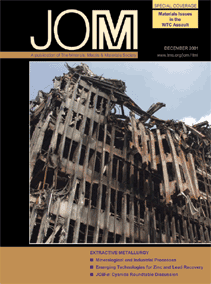 |
NEWS & UPDATE
|
|---|
 |
NEWS & UPDATE
|
|---|
|
|
|---|
 |
|
OTHER ARTICLES IN THE WTC SERIES |
| Why Did the World Trade Center Collapse? Science, Engineering, and Speculation by Thomas Eagar and Christopher Musso Better Materials Can Reduce the Threat from Terrorism by Toni G. Maréchaux An Initial Microstructural Analysis of A36 Steel from WTC Building 7 by J.R. Barnett, R.R. Biederman, and R.D. Sisson, Jr. |
|
|
As fears of chemical and biological warfare escalate, a system of sensors
developed by the U.S. Department of Energy’s Sandia National Laboratories
has been offered as a potential preventative tool. The system is designed
to continually monitor water or air, in-situ, so sample collecting is not
necessary. It is based on an array of four miniature sensors, or chemresistors,
that can detect potentially harmful volatile organic compounds (VOC), such
as aromatic hydrocarbons, chlorinated solvents, aliphatic hydrocarbons, alcohols,
and ketones. It has also been found to detect agents that are analogous to
nerve gas, said Cliff Ho, a Sandia researcher. The chemresistors are fabricated
by mixing a commercial polymer dissolved in a solvent with conductive carbon
particles. That solvent is applied to wire-like electrodes on a specially
designed microfabricated circuit. When VOCs are present, the chemicals absorb
into the polymers, causing them to swell. Chemical resistance changes result,
which can be measured and recorded.
The system, which would be left at the site to be monitored, would send to
a remote computer messages about solvents present and their concentrations.
Comparing the resulting chemical signatures with those of known samples can
identify different VOCs.
The sensors are packaged in a small, but sturdy, waterproof housing that allows
them to be exposed to both liquid and gaseous VOCs. The housing has a small
opening covered by a GORE-TEX membrane that repels liquid, but allows vapors
to penetrate. When submerged in contaminated water, VOCs dissolved in the
water will cross the membrane the gas phase, where they can be detected by
the chemresistors.
The chemresistors are placed on a 16-pin dual inline package connected to
a long, weatherproof cable. That cable can be connected to any data logger
to transmit measurements.
The monitoring method would be less expensive than those used traditionally,
according to Sandia, while providing more current information with less room
for error. When samples are collected and taken to an off-site laboratory
for analysis, the integrity of the sample might be compromised.
“(The sensor package) has the capability of detecting in real time undesirable
chemicals being pumped into the water supply accidentally or intentionally.
It will be able to monitor sites containing toxic chemical spills, leaking
underground storage tanks, and chemical waste dumps,” Ho said.
Field tests are being conducted to determine the longevity of the sensor and
the effect of temperature variations, barometric pressure changes, and ground
humidity. The technology is expected to be commercially available within one
to three years.
In addition to the sensor research, Sandia is working with the U.S. Environmental
Protection Agency and the American Water Works Association Research Foundation
to develop a program to train water utilities to assess system vulnerabilities.
The assessment is based on three steps: detect the problem, delay infiltration
into the common water supply, and respond.
Direct questions about this or any other JOM page to jom@tms.org.
| If you would like to comment on the December 2001 issue of JOM, simply complete the JOM on-line critique form | |||||
|---|---|---|---|---|---|
| Search | TMS Document Center | Subscriptions | Other Hypertext Articles | JOM | TMS OnLine |